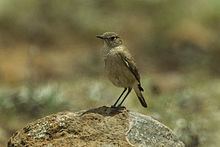Order Passeriformes Genus Cercomela Higher classification Cercomela | Phylum Chordata Family Muscicapidae Scientific name Cercomela sinuata Rank Species | |
 | ||
Similar Karoo chat, Tractrac chat, Sentinel rock thrush, Sombre rock chat, Karoo scrub robin | ||
The sickle-winged chat or sicklewing chat (Cercomela sinuata) is a small passerine bird of the Old World flycatcher family Muscicapidae endemic to southern Africa. It is a common resident breeder in South Africa and Lesotho, and is also found in southernmost areas of Botswana and Namibia. Its habitat is Karoo scrub, short grassland, and barren sandy or stony areas. In western coastal areas, it also occurs on agricultural land.
Contents
Taxonomy
The sickle-winged chat was formerly placed in the genus Cercomela. It was suggested to be placed in Emarginata after molecular phylogenetic studies published in 2010 and 2012 found that Cercomela was polyphyletic., however many taxonomists continue to place the bird in Cercomela.
Description
The sickle-winged chat is 14–15 cm long and weighs around 19 gm. Its upperparts are dark grey, but it has brown wings and a rufous patch behind the eye. The tail and rump are buff-pink, with an inverted wedge of black at the end of the tail. Its underparts are off-white, the short straight bill, legs and feet are black and the eye is brown. The sexes are similar, but the juvenile has buff tips to its feathers.
The contrast between the dark upperparts and the much paler underparts distinguish this species from the more uniformly coloured familiar chat. It also has the pale salmon-buff on the rump extending only onto the base of the tail, whereas the familiar chat has a richer hue which almost reaches the tip of the tail.
The sickle-winged chat has a chak-chak call and a warbled song.
Behaviour
The sickle-winged chat builds a cup-shaped nest of straw and leaves on the ground, usually under a bush or shrub. It lays two to four green or blue eggs. This species is monogamous.
The sickle-winged chat is usually seen singly or in pairs. It forages on the ground or at the base of trees for insects.
In comparison with the familiar chat, it spends more time on the ground and runs more swiftly. It flicks its wings, but less frequently than the familiar chat.
Conservation status
This common species has a large range, with an estimated extent of 850,000 km2. The population size is believed to be large, and the species is not believed to approach the thresholds for the population decline criterion of the IUCN Red List (i.e. declining more than 30% in ten years or three generations). For these reasons, the species is evaluated as Least Concern.
